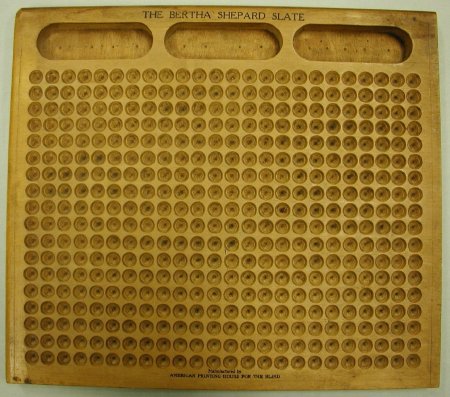Object ID:
1992.83
Title:
Prototype Bertha Shepard Slate
Description:
Plywood prototype arithmetic slate has conical cells (432 total: 18 cells vertically by 24 cells horizontally) and three oval tray compartments to hold the type; top edge is rounded; slight line incised on borders of top and bottom; stenciled "The Bertha Shepard Slate" and is stamped "Manufactured by AMERICAN PRINTING HOUSE FOR THE BLIND."
Date:
ca. 1932
Made by:
American Printing House for the Blind
Place of Origin:
Louisville, KY
Collection:
APH Collection
Provenance:
This is a model, the final version was cast in aluminum and featured pentagonal holes. Pentagonal arithmetic frames were originally developed at the Glasgow Asylum for the Blind around 1829. By turning the type in place, numbers 0-9 and operators were represented. APH began experimenting with different styles of arithmetic frames in the 1930s. In a letter to the head of the American Foundation for the Blind, Robert Irwin, APH President A.C. Ellis reported that he hoped to have a "small supply" of a pentagonal arithmetic frame available as early as January 1933. The frames first entered the catalog in 1935. By 1937, however, the pentagonal frame was no longer in the catalog, in favor of a gridded frame which used type cast with raised numerals in the "Philadephia style." A year later, APH introduced its version of the Taylor arithmetic slate, which used octagonal holes, but was similar in concept to the pentagonal design.
Credit Line:
APH Collection, 1992.83.
